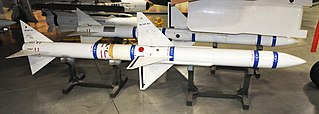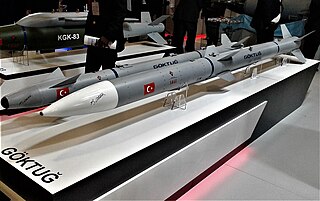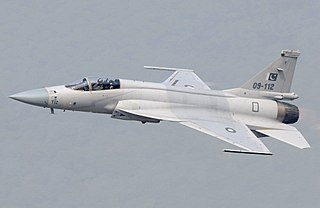Related Research Articles

The AIM-7 Sparrow is an American medium-range semi-active radar homing air-to-air missile operated by the United States Air Force, United States Navy, United States Marine Corps, and various other air forces and navies. Sparrow and its derivatives were the West's principal beyond visual range (BVR) air-to-air missile from the late 1950s until the 1990s. It remains in service, although it is being phased out in aviation applications in favor of the more advanced AIM-120 AMRAAM.

The AIM-120 Advanced Medium-Range Air-to-Air Missile(AMRAAM) ( AM-ram) is an American beyond-visual-range air-to-air missile capable of all-weather day-and-night operations. It uses active transmit-receive radar guidance instead of semi-active receive-only radar guidance. When an AMRAAM missile is launched, NATO pilots use the brevity code "Fox Three".

The Northrop F-5 is a family of supersonic light fighter aircraft initially designed as a privately funded project in the late 1950s by Northrop Corporation. There are two main models: the original F-5A and F-5B Freedom Fighter variants, and the extensively updated F-5E and F-5F Tiger II variants. The design team wrapped a small, highly aerodynamic fighter around two compact and high-thrust General Electric J85 engines, focusing on performance and a low cost of maintenance. Smaller and simpler than contemporaries such as the McDonnell Douglas F-4 Phantom II, the F-5 costs less to procure and operate, making it a popular export aircraft. Though primarily designed for a day air superiority role, the aircraft is also a capable ground-attack platform. The F-5A entered service in the early 1960s. During the Cold War, over 800 were produced through 1972 for US allies. Despite the United States Air Force (USAF) not needing a light fighter at the time, it did procure approximately 1,200 Northrop T-38 Talon trainer aircraft, which were based on Northrop's N-156 fighter design.

The Rafael Python (פיתון) is a family of air-to-air missiles (AAMs) built by the Israeli weapons manufacturer Rafael Advanced Defense Systems, formerly RAFAEL Armament Development Authority. Originally starting with the Shafrir series, the Shafrir-1 missile was developed in 1959, followed by the Shafrir-2 in early 1970s. Subsequently, the missiles were given the western name of "Python" by the parent company for export purposes, starting with the Python-3 in 1978. Since then, it has been further developed and evolved into the Python-4, Python-5, Derby and also, the SPYDER, an advanced ground-based air-defence system. Currently, the missiles are in service with the armed forces of over fifteen countries from around the world.

An air-to-air missile (AAM) is a missile fired from an aircraft for the purpose of destroying another aircraft. AAMs are typically powered by one or more rocket motors, usually solid fueled but sometimes liquid fueled. Ramjet engines, as used on the Meteor, are emerging as propulsion that will enable future medium- to long-range missiles to maintain higher average speed across their engagement envelope.

The Atlas Cheetah is a South African fighter aircraft designed and produced by the aviation company Atlas Aircraft Corporation. It was primarily designed and developed to be operated by the South African Air Force (SAAF).

The South African National Defence Force (SANDF) comprises the armed forces of South Africa. The commander of the SANDF is appointed by the President of South Africa from one of the armed services. They are in turn accountable to the Minister of Defence and Military Veterans of the Defence Department.
A beyond-visual-range missile is an air-to-air missile that is capable of engaging at ranges around 40 km (22 nmi) or beyond. This range has been achieved using dual pulse rocket motors or booster rocket motor and ramjet sustainer motor. Medium-range, long-range, and very-long-range air-to-air missiles fall under the category of beyond-visual-range missiles. Older BVR missiles generally used the semi-active radar homing, and modern BVR missiles use the active radar homing guidance.

Astra is an Indian family of all weather beyond-visual-range air-to-air missile, developed by the Defence Research and Development Organisation. Different missiles of this family are capable of engaging targets at varying distances of 500 m (0.31 mi) up to 340 km (210 mi). Astra Mk-1 has been integrated with Indian Air Force's Sukhoi Su-30MKI and will be integrated with Dassault Mirage 2000, HAL Tejas and Mikoyan MiG-29 in the future. Limited series production of Astra Mk-1 missiles began in 2017.

The CAC/PAC JF-17 Thunder, or FC-1 Xiaolong, is a lightweight, single-engine, multirole combat aircraft developed jointly by the Pakistan Aeronautical Complex (PAC) and Chengdu Aircraft Corporation (CAC) of China. It was designed and developed as a replacement for the A-5C, F-7P/PG, Mirage III, and Mirage V combat aircraft in the Pakistan Air Force (PAF). The JF-17 can be used for multiple roles, including interception, ground attack, anti-ship, and aerial reconnaissance. The Pakistani designation "JF-17" stands for "Joint Fighter-17", with the "Joint Fighter" denoting the joint Pakistani-Chinese development of the aircraft and the "-17" denoting that, in the PAF's vision, it is the successor to the F-16. The Chinese designation "FC-1" stands for "Fighter China-1".

An air superiority fighter is a fighter aircraft designed to seize control of enemy airspace by establishing tactical dominance over the opposing air force. Air-superiority fighters are primarily tasked to perform aerial combat against agile, lightly armed aircraft and eliminate any challenge over control of the airspace, although some may have a secondary role for air-to-surface attacks.

The Umkhonto is a family of vertical-launched, surface-to-air missiles developed by Denel Dynamics. Umkhonto is designed to be a modern, short to medium-range missile, with an all-weather launch capability. Operating at supersonic speeds, the Umkhonto utilises infrared homing technology to provide point and limited local air defence against multiple attacks of aircraft and missiles.
The Denel Overberg Test Range is a weapons systems testing facility in the Overberg region on the south coast of South Africa, near Arniston, Western Cape. It includes launch pads and tracking systems.

Dissimilar air combat training (DACT) was introduced as a formal part of US air combat training after disappointing aerial combat exchange rates in the Vietnam War.
Denel Aeronautics is the aviation and aerospace division of the state-owned Denel corporation of South Africa. It is one of the successors of the South African aviation company Atlas Aircraft Corporation.
The V3E A-Darter is a modern short-range infrared homing air-to-air missile, featuring countermeasures resistance with a 180-degree look angle and 120-degrees per second track rate, developed by South Africa's Denel Dynamics and Brazil's Mectron, Avibras and Opto Eletrônica. It will equip the South African Air Force's Saab JAS 39 Gripen C/D and BAE Hawk 120, and the Brazilian Air Force's A-1M AMX, Northrop F-5BR and Gripen E/F. It was expected to be in production before the end of 2015. As of November 2022, no combat capable missiles had been produced.
The Atlas Carver was a proposed South African twin-engine, delta wing fourth-generation fighter aircraft. In development during the 1980s and early 1990s, the Carver was ultimately cancelled during 1991.

The KLJ-7, also referred to as the Type 1478, is an X band airborne fire-control radar (FCR) developed by Nanjing Research Institute of Electronic Technology (NRIET), also known as the China Electronics Technology Company's (CETC's) No. 14 Research Institute. In December 2010, Pakistan Air Force's Air Chief Marshal Rao Qamar Suleman announced that KLJ-7 radar will be built at Pakistan Aeronautical Complex (PAC), in Kamra, north of Islamabad.

No. 11 Squadron, named the Arrows, is a Pakistan Air Force (PAF) fighter squadron assigned to the No. 39 Multi-Role Wing of the PAF Southern Air Command. It operates the Block 15 MLU model of the F-16 Fighting Falcon with a multi-role tasking and is also an Operational Conversion Unit (OCU).

The Umbani is a precision-guided bomb kit manufactured by Denel Dynamics in South Africa. It consists of a number of modules fitted to NATO standard Mk81, Mk82 or Mk83 low drag free-fall bombs to convert them into guided glide bombs.
References
- ↑ "NCACC inspectorate probing Icarus Marine". 12 October 2010.
- ↑ "The South African Air Force".
- ↑ "International Assessment and Strategy Center > Research > China's Emerging 5th Generation Air-to-Air Missiles". Archived from the original on 21 October 2009. Retrieved 1 November 2016.
- ↑ "Air Force Acquiring Additional F-5s and Evaluating R-Darter Missiles for Upgraded F-5s". Forecast International. January 2006. Archived from the original on 27 September 2007. Retrieved 6 March 2007.
- ↑ Engelbrecht, Leon (12 October 2010). "NCACC inspectorate probing Icarus Marine". Defence Web (defenceweb.co.za). Retrieved 31 May 2011.
defenceWeb could find no record of Denel sales to Pakistan, but the International Institute for Strategic Studies notes in its 2010 Military Balance publication that the Pakistan Air Force operates the "R-Darter" a beyond visual-range air-to-air missile.